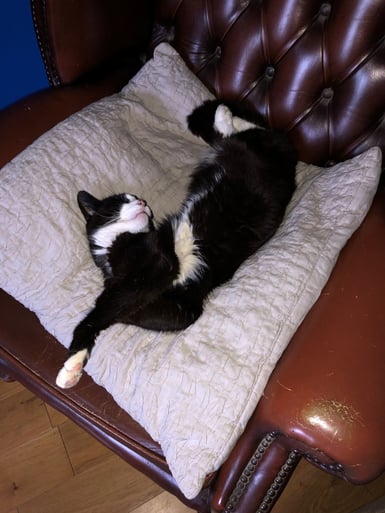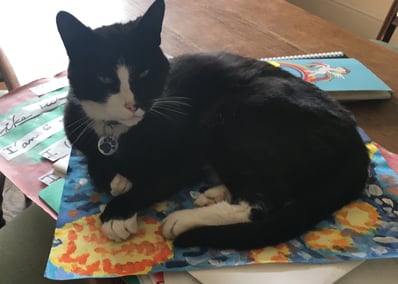This is Pepper.
- Pepper likes to visit other people’s houses and persuade them he doesn’t get fed at home.
- He has to be sedated before he can go to the vets, or he will fight them to the death.
- He enjoys bashing his two dog siblings, and taking their beds.
- He likes to hunt, specialises in crisp packets, but once brought home a live rabbit.
- Now he’s older, Pepper likes bird-watching, and sitting on laps.
- When he’s lonely at night time, Pepper sneaks under the children’s duvets and bites their legs - for the company. Even if it involves screaming.
Pepper, in other words, is a brilliant, brilliant cat.
He’s also a very expensive one…
The adventures of Pepper
In one of Pepper’s biggest adventures, he actually went missing.
For five years.
 Although my husband insisted he was still out there living his best life somewhere, I honestly thought he was dead. And because I thought he was dead, I cancelled the insurance policy my husband got out for him when he was a kitten.
Although my husband insisted he was still out there living his best life somewhere, I honestly thought he was dead. And because I thought he was dead, I cancelled the insurance policy my husband got out for him when he was a kitten.
You can imagine my surprise when we got a call from the RSPCA saying they’d found him, 8 miles from where he was last seen.
Getting Pepper back was great – but Pepper himself wasn’t doing so well. He’d got himself in a bit of a mess. In those first few weeks home, we spent more than £1,000 on urgent dental work to fix his teeth so he could eat, and then hundreds more on blood tests to find out why he still wasn’t putting any weight on.
It turned out Pepper – now 16 - had developed a thyroid condition, had fluid on his lungs, and joint problems to boot.
Pepper now takes 5 pills a day, liquid medicine on his very expensive food 3 times a day, and visits the vet at least every 3 months for blood tests and check-ups.
Pepper costs me a couple of hundred pounds every single month – from my own pocket.
Creeping costs
I’m in the incredibly lucky position that I can pay to keep Pepper well, and with us, in his final senior years. But I had no idea quite how quickly age-related health conditions could creep up, and how much treatment would actually cost.
Because we don’t pay for our own medicine or treatment in the UK, we don’t realise how expensive it is. A pussy-cat blood tests costs me around £80. Treatment for more severe conditions, injuries or operations be even more expensive. A friend’s cat tried bowling over her boyfriend on the stairs, and ended up getting landed on, and breaking its leg in 3 places. The treatment options were to put it down, amputate the leg for £1,500, or get metal pins put in for £3,500.
Fortunately, she DID have insurance, and so she now has a bionic cat, who wouldn’t get through airport security. But if you don’t have that insurance, or you don’t have the right kind of policy, you’d have to pay out of your own pocket, or see your pet put down.
Most people simply don’t have that kind of disposable income – especially right now.
Pet insurance pit-falls
It’s very easy to look at your healthy pet and think it’s not worth the money. But it’s very hard to look at a much-loved member of the family and decide whether or not you can afford to chop off its leg.
It’s also easy if you DO choose to buy non-compulsory insurance like pet insurance to go for the cheapest possible option. Lots of people get confused by the different types of pet insurance – because they’re not familiar with terms like ‘age limited’ or ‘maximum benefit’ – neither of which are likely to cover ongoing conditions, or touch the sides of a broken-leg claim.

When I looked at getting a new policy for Pepper, I was shocked at how difficult it was to find cover. He’s not a kitten anymore, he’s an elderly gentleman with pre-existing health conditions – and nobody wants to insure him.
I’ve worked in insurance for nearly 20 years.
If I didn’t know about the pit-falls of expensive treatments, low/limited cover and age/condition penalties - then I’m pretty sure other people don’t either.
Lessons for the pet insurance market
As the pet insurance market explodes, the winners could well be the firms helping pet owners really understand their risks – and their options.
Knowing how, where and why people are buying, what’s putting them off, what competitors are doing, and what ‘fair value’ in pet insurance looks like - is absolutely key.
If you want to see where the opportunity is, and how you can harness it, join our webinar, 'It's raining cats and dogs: Understanding consumer behaviour in the wake of the pet boom', this Thursday at 11am.
WEBINAR: It's raining cats and dogs
Understanding consumer behaviour in the wake of the pet boom
As an existing pet insurer or a brand thinking of entering the pet insurance market, it’s important to understand the size of the opportunity. A key component of this is building your understanding of consumer behaviour in this space.
In our upcoming webinar, we will be revealing exclusive data from our brand-new Pet Insurance Behaviour Tracker - which tracks the behaviour of cat and dog owners - to help you on your journey.
Comment . . .



Submit a comment